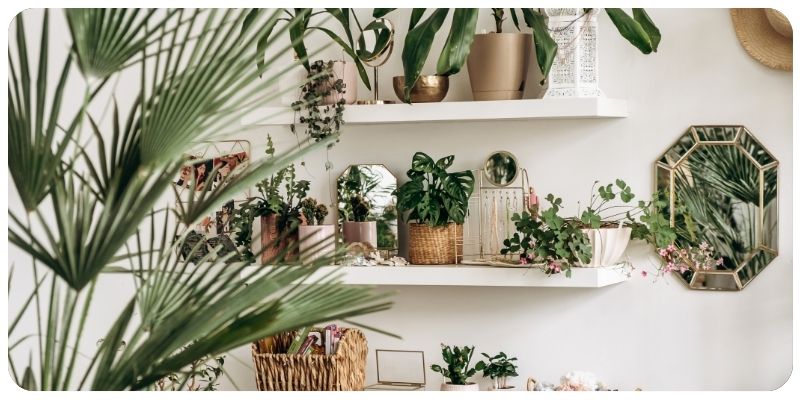
How to Keep Your Indoor Garden Thriving in Winter
Winter can be a challenging time for indoor plants, as the shorter days and cooler temperatures can affect their growth. However, with the right care and adjustments to your gardening routine, you can keep your indoor garden thriving even in the coldest months. In this guide, we'll cover essential winter care tips for indoor plants, including light, watering, humidity, and temperature management.
1. Adjusting Light for Winter
During winter, the days are shorter, and there is less natural sunlight. Most indoor plants thrive on bright, indirect light, but the reduced sunlight can slow down their growth. To help your plants get enough light, you can make a few adjustments:
Maximizing Natural Light
- Move Plants Closer to Windows: Place your plants closer to windows where they can receive more natural light. South-facing windows usually get the most sunlight in winter.
- Clean Your Windows: Dust and dirt on windows can block sunlight. Keep your windows clean to ensure maximum light penetration.
- Rotate Plants: Rotate your plants every week to ensure all sides receive equal exposure to light.
Using Grow Lights
If your home doesn't receive enough natural light during the winter months, consider using grow lights. These artificial lights are designed to provide the full spectrum of light that plants need to grow:
- LED Grow Lights: These energy-efficient lights are perfect for indoor plants and can be set up to provide supplemental light for 8-12 hours a day.
- Fluorescent Lights: Fluorescent lights are another option and can help boost light levels during winter. Place the lights about 6-12 inches above the plants.
2. Watering Indoor Plants in Winter
Overwatering is one of the most common mistakes during winter, as plants generally need less water in colder months. With less sunlight and slower growth, indoor plants can become waterlogged if watered too frequently.
Water Less Frequently
- Check the Soil: Always check the soil before watering. If the top inch of soil feels dry, it’s time to water, but if it’s still moist, wait a few more days.
- Use Room-Temperature Water: Cold water can shock plant roots. Always use room-temperature water to avoid stressing the plants.
Avoid Overwatering
Overwatering can lead to root rot, a common problem for indoor plants in winter. To avoid overwatering:
- Use Pots with Drainage: Make sure your pots have drainage holes to prevent water from accumulating at the bottom.
- Empty Drainage Trays: If your pots sit on trays, always empty excess water from the trays after watering.
3. Maintaining Humidity Levels
Indoor heating systems can reduce humidity levels, making the air drier, which can affect indoor plants. Many houseplants, especially tropical varieties, thrive in humid environments, so it’s important to maintain humidity levels during winter.
Increase Humidity
- Use a Humidifier: A humidifier is the most effective way to maintain humidity levels around your plants. Aim for a humidity level of 40-50% for most indoor plants.
- Mist the Plants: Lightly mist the leaves of your plants with water every few days to help maintain moisture.
- Group Plants Together: Placing plants close to each other creates a microenvironment with higher humidity, as the plants release moisture through transpiration.
4. Regulating Temperature for Winter Plants
Most indoor plants prefer temperatures between 60-75°F (15-24°C). During winter, cold drafts from windows or doors can lower the temperature and affect plant health. On the other hand, hot air from heating vents can dry out plants.
Protect Plants from Temperature Extremes
- Keep Plants Away from Drafts: Avoid placing plants near doors, windows, or other areas where they may be exposed to cold drafts.
- Move Plants Away from Heat Sources: Keep plants away from radiators, heaters, or vents where hot, dry air can cause stress to the plants.
- Maintain Stable Temperatures: Try to keep the temperature consistent, avoiding large fluctuations between day and night.
5. Fertilizing Indoor Plants in Winter
Indoor plants typically enter a period of dormancy or slow growth during the winter months, so they do not require as much fertilizer. Over-fertilizing during this time can harm the plants and lead to nutrient burn.
Reduce Fertilizer Use
- Fertilize Sparingly: Reduce the frequency of fertilizing to once every 6-8 weeks, or stop altogether until spring.
- Use Diluted Fertilizer: If you do fertilize, use a diluted solution to avoid overwhelming the plants during their dormant period.
Conclusion
With the right care and adjustments, you can keep your indoor garden thriving during the winter months. Focus on providing adequate light, maintaining the right watering schedule, increasing humidity, and regulating temperatures. By paying attention to your plants’ needs, you'll ensure they stay healthy and vibrant even when the weather outside is cold and harsh.